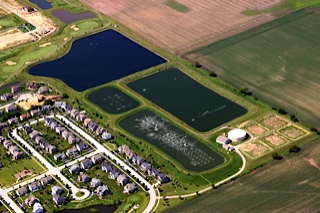6 Tips to Remove Ammonia from Wastewater Lagoons
Removing ammonia from wastewater lagoons has become a hot topic over the past few years. State Environmental Protection Agencies have been introducing new ammonia limits for aerated wastewater lagoons. This is a problem because most wastewater lagoon systems were not originally designed for ammonia treatment. As a result, most lagoon systems will require some kind of upgrade.

In this article, we’ll discuss one of the main processes by which to remove ammonia from wastewater lagoons, namely nitrification. In the event that your lagoon needs upgrades, this will help you narrow down your options.
Nitrification is the most common way to biologically remove ammonia in wastewater lagoons. In this process, ammonia treatment occurs via bacteria already present in the water. These bacteria break down the ammonia and eventually promote the release of nitrogen gas into the atmosphere. The end result is that your wastewater lagoon ammonia is nitrified, resulting in lower ammonia levels in your lagoon effluent.
Wastewater Lagoon Ammonia Removal via Nitrification Requires:
- Healthy levels of dissolved oxygen (DO) in your lagoon—Wastewater lagoon nitrification consumes large quantities of oxygen. Just for reference, every pound of BOD oxidized consumes 1.5 lb/O2. On the other hand, according to Metcalf & Eddy, every pound of ammonia oxidized consumes 4.57 lb/O2. In order for lagoon nitrification to occur, a minimum working DO level of 2.0 mg/L is required and a DO level of 5 mg/L is optimal. As a result, you must ensure that your lagoon aeration system is properly sized, and working efficiently and effectively enough to provide the oxygen needed to remove ammonia from your wastewater lagoon via nitrification.
- BOD to be removed first—Nitrifying bacteria do not compete well against BOD-removing heterotrophic bacteria. For nitrification to take place, BOD levels must be sufficiently reduced in order to eliminate competition. Generally a BOD level of 20–30 mg/L is required before lagoon ammonia removal can begin occurring.
- Lagoon pH needs to be 7.5–8.0—Lagoon nitrification is pH-sensitive, and ammonia treatment rates decline significantly at pH values below 6.8. Optimal lagoon nitrification rates occur at pH values in the 7.5 to 8.0 range. Most municipal wastewater lagoons will naturally have a pH in this range. However, industrial wastewater lagoons may vary, so be sure to monitor these levels closely.
- Sufficient lagoon water temperature—Similar to many other wastewater lagoon treatment processes, nitrification slows as water temperature decreases. Optimal temperature range for lagoon nitrification is 82 to 97 degrees Fahrenheit. This is clearly unrealistic for most wastewater lagoons, but acceptable rates of lagoon nitrification can also be achieved at or above 68 degrees F.
- Adequate mixing—Ammonia can be released as a result of sludge accumulation being anaerobically digested at the bottom of the lagoon. Without sufficient lagoon mixing, sludge levels will undoubtedly increase. As a result, ammonia effluent levels can actually end up being higher than that of influent. Ideally, it is recommended that sludge depths remain below 2 feet. Another adverse effect of a poorly mixed lagoon is “Short Circuiting.” This occurs when a basin becomes stratified, allowing influent flows take a “short cut” through it by only moving through the top layer (or stratum) of the water. This lack of homogeneity results in reduced retention time for the water, and generally leads to poor overall treatment, including poor BOD and ammonia treatment.
- Absence of toxins that can inhibit the process—Nitrifying bacteria are more easily inhibited by compounds such as heavy metals than are the BOD-reducing bacteria. Make sure your wastewater does not have any toxins that might inhibit lagoon nitrification.
Lagoon ammonia removal via nitrification is not an easy process to master, and with new lagoon ammonia effluent requirements, it’s a problem that won’t go away any time soon. By investing in the right infrastructure and treatment system, as well as monitoring the right constituents, you can stay ahead of the curve in terms of wastewater lagoon ammonia treatment.
Triplepoint’s NitrOx® system allows municipalities—in all climates—to meet ammonia effluent limits in any weather. It integrates into the existing lagoon infrastructure to minimize capital and operational costs.
Learn more by downloading our NitrOx brochure.
